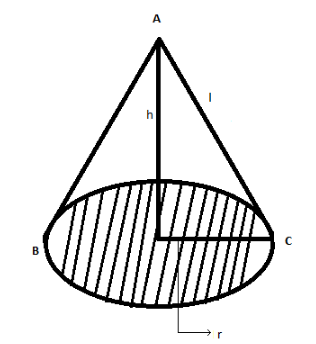
The area of the base of cone is 616 $cm^2$ and its height is 48 cm. the total surface area of the cone is
A. $ 2816\;c{m^2} $
B. $ 2861\;c{m^2} $
C. $ 2618\;c{m^2} $
D. $ 2681\;c{m^2} $
Answer
451.5k+ views
Hint: We have the base area of the cone and its height. To find the total surface area of the cone we have firstly calculate the radius of the cone. We calculate it from the base area of the cone. Once we calculate the base area then we calculate the slant height of the cone. Slant height is calculated with the help of radius and height of the cone. After calculating all this we use the formula of total surface area of cones. This will give us the required answer.
Complete step-by-step answer:
We have given height of cone (h) = 48 cm
base area of the cone = 616 $cm^2$
The shaped region shows the base area of the cone. Let r be the radius and l be the slant height of the cone.
Firstly we calculate radius of cone, base area of cone = 616 $cm^2$
\[ = \pi {r^2}\]Since the shape of the base of the cone is a circle. So, base area of cone = Area of circle

Therefore $ \pi {r^2} = 616 $ ; $ \pi = \dfrac{{22}}{7} $
Therefore $ \dfrac{{22}}{7} \times {r^2} = 616 $
$ \Rightarrow {r^2} = 616 \times \dfrac{7}{{22}} $
$ {r^2} = 28 \times 7 $
$ r = \sqrt {196} = 14 $
So, radius of cone = 14 cm
Now we calculate the slant height of the cone.
Slant height of cone $ = \sqrt {{r^2} + {h^2}} $
$ l = \sqrt {{{14}^2} + {{48}^2}} = \sqrt {196 + 2304} = \sqrt {2500} = 50 $
So, slant height of the cone is = 50cm
Now, we have to calculate the total surface area of the cone.
Total surface area of cone = curved surface area +base area of cone
$ = \pi rl + \pi {r^2} $
$ = \pi r(l + r) $
$ = \dfrac{{22}}{7} \times 14(50 + 14) = \dfrac{{22}}{7} \times 14 \times 64 $
$ = 2816\;c{m^2} $
So, the correct answer is “Option A”.
Note: Cone is a three dimensional solid structure that has a circular base. A cone can be viewed as a set of non- congruent circular disks that are placed over one another in such a way that the ratio of the radius of adjacent disk remains constant.
Complete step-by-step answer:
We have given height of cone (h) = 48 cm
base area of the cone = 616 $cm^2$
The shaped region shows the base area of the cone. Let r be the radius and l be the slant height of the cone.
Firstly we calculate radius of cone, base area of cone = 616 $cm^2$
\[ = \pi {r^2}\]Since the shape of the base of the cone is a circle. So, base area of cone = Area of circle

Therefore $ \pi {r^2} = 616 $ ; $ \pi = \dfrac{{22}}{7} $
Therefore $ \dfrac{{22}}{7} \times {r^2} = 616 $
$ \Rightarrow {r^2} = 616 \times \dfrac{7}{{22}} $
$ {r^2} = 28 \times 7 $
$ r = \sqrt {196} = 14 $
So, radius of cone = 14 cm
Now we calculate the slant height of the cone.
Slant height of cone $ = \sqrt {{r^2} + {h^2}} $
$ l = \sqrt {{{14}^2} + {{48}^2}} = \sqrt {196 + 2304} = \sqrt {2500} = 50 $
So, slant height of the cone is = 50cm
Now, we have to calculate the total surface area of the cone.
Total surface area of cone = curved surface area +base area of cone
$ = \pi rl + \pi {r^2} $
$ = \pi r(l + r) $
$ = \dfrac{{22}}{7} \times 14(50 + 14) = \dfrac{{22}}{7} \times 14 \times 64 $
$ = 2816\;c{m^2} $
So, the correct answer is “Option A”.
Note: Cone is a three dimensional solid structure that has a circular base. A cone can be viewed as a set of non- congruent circular disks that are placed over one another in such a way that the ratio of the radius of adjacent disk remains constant.
Recently Updated Pages
Glucose when reduced with HI and red Phosphorus gives class 11 chemistry CBSE

The highest possible oxidation states of Uranium and class 11 chemistry CBSE

Find the value of x if the mode of the following data class 11 maths CBSE

Which of the following can be used in the Friedel Crafts class 11 chemistry CBSE

A sphere of mass 40 kg is attracted by a second sphere class 11 physics CBSE

Statement I Reactivity of aluminium decreases when class 11 chemistry CBSE

Trending doubts
Fill the blanks with the suitable prepositions 1 The class 9 english CBSE

How do you graph the function fx 4x class 9 maths CBSE

Difference Between Plant Cell and Animal Cell

What is pollution? How many types of pollution? Define it

What is the color of ferrous sulphate crystals? How does this color change after heating? Name the products formed on strongly heating ferrous sulphate crystals. What type of chemical reaction occurs in this type of change.

Distinguish between Conventional and nonconventional class 9 social science CBSE




